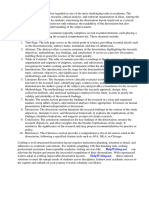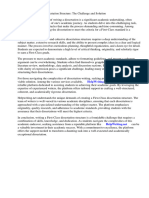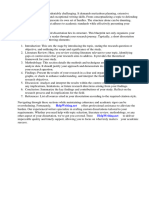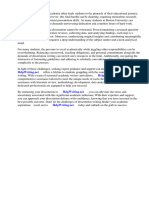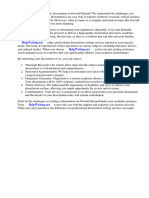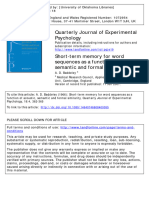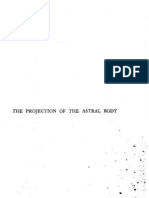English Literature Dissertation Structure
English Literature Dissertation Structure
Uploaded by
BuyACollegePaperCanadaOriginal Description:
Copyright
Available Formats
Share this document
Did you find this document useful?
Is this content inappropriate?
Report this DocumentCopyright:
Available Formats
English Literature Dissertation Structure
English Literature Dissertation Structure
Uploaded by
BuyACollegePaperCanadaCopyright:
Available Formats
Title: Navigating the Challenges of Crafting an English Literature Dissertation Structure
Embarking on the journey of writing a dissertation in English Literature is a formidable task that
demands dedication, extensive research, and a profound understanding of the subject matter. As
students delve into the complexities of crafting a dissertation structure, they often find themselves
grappling with the intricacies of this academic endeavor.
The first challenge lies in formulating a comprehensive and cohesive dissertation structure that
effectively communicates the research findings and analysis. Establishing a logical flow while
maintaining the integrity of the content is a meticulous process that requires careful planning and
organization.
Selecting an appropriate topic and narrowing it down to a focused research question further adds to
the difficulty. Students must navigate through a vast sea of literature, critically evaluating existing
research, and identifying gaps to contribute meaningfully to the academic discourse.
The incorporation of theoretical frameworks and methodologies poses another hurdle. The selection
and application of relevant theories and methods necessitate a deep understanding of the research
landscape, adding layers of complexity to the dissertation structure.
Moreover, grappling with the voluminous data and sources requires adept research skills. Students
must sift through an abundance of information, discerning the most pertinent sources to substantiate
their arguments and contribute to the existing body of knowledge.
To alleviate the burden of these challenges, students often seek external assistance from reputable
sources. One platform that stands out in providing expert guidance and support is ⇒
HelpWriting.net ⇔. By opting for professional assistance, students can streamline the dissertation
writing process, ensuring a well-structured, insightful, and academically rigorous final document.
Helpwriting.net offers a dedicated team of experienced writers with expertise in English Literature.
Their comprehensive services encompass topic selection, literature review, methodology formulation,
and the overall structuring of the dissertation. By entrusting the task to skilled professionals, students
can focus on honing their research and analytical skills while ensuring a polished and compelling
dissertation.
In conclusion, crafting an English Literature dissertation structure is undoubtedly a formidable task.
The intricate process involves meticulous planning, extensive research, and a deep understanding of
the subject matter. For those seeking support and guidance, ⇒ HelpWriting.net ⇔ stands as a
reliable ally, providing expert assistance to navigate the challenges and deliver a dissertation that
meets the highest academic standards.
Have you ever wondered if writing lengthy projects can give you stress. Choose a subject that aligns
with your interests and allows you to showcase the skills and knowledge you have acquired through
your degree. 2. Research your supervisor. And even if they do have a prescribed structure, you’ll still
get value from this post as we’ll explain the core contents of each section. Details of how, when,
where, and what of the research that was conducted. The introduction is the first section of your
thesis or dissertation, appearing right after the table of contents. Unlike in a regular essay, chapter
conclusions may also introduce the chapter that will follow, indicating how the chapters are
connected to one another and how the argument will develop through your dissertation. For example
a scientific dissertation will have a clear separation between the results and the discussion of results
presented; whereas a social science dissertation will contain a findings section that brings the results
and discussion together to formulate a conclusion. An introduction may also identify gaps in the
research and how the writer intends to fill those gaps, as well as an outline of the scope of the
investigation and the general and argumentative structure of the dissertation. 3. The Literature
Review (25%) The largest section of a dissertation is usually the literature review, which aims to
provide a detailed discussion of the existing research that’s most relevant to the investigation.
Remember, talking openly with your supervisor helps you both understand each other better,
improves your dissertation and ensures that you get the support you need. Table of Contents Table of
contents is the section of a dissertation that guides each section of the dissertation paper’s contents.
Some universities will want additional bells and whistles in the intro chapter, so be sure to carefully
read your brief or consult your research supervisor. This section is crucial for replicating the study
and validating its results. You can then delve into whether you achieved the goals you set at the
beginning and reflect on whether your research addressed the topic as expected. I’m going to
bookmark your site and keep checking for new details about once a week, I could do with some
MBA dissertations if possible. Thanks. It provides a detailed description of the methods you used to
conduct your research and helps readers understand how you obtained your data and how you plan
to analyze it. From my personal experiences, I always checked to see if I could find every reference
in the bibliography in the main body of the dissertation this means that you can locate any missing
references and add them without running the risk of plagiarism. Don't pick those goals that are not
possible to achieve. Writing a thesis can be an overwhelming task for many college and graduate
students. Furthermore, your methods section should convince your reader that your method was the
best way to answer your research question. As a student, you will need to check which style of
academic writing is best suited to your field of study. Every statements and argument should be
delivered properly. This could involve explaining the type of study (e.g., case study, ethnography,
experimental research, etc.), how you’ve defined and measured your variables, and any control
measures you’ve implemented. 4. Data Collection Explain in detail how you collected your data.
Unfortunately, many university professors and advisors assume that their students know how to
structure a PhD. In this post, we’ll look at the 7 essential ingredients of a strong dissertation or thesis
introduction chapter, as well as the essential things you need to keep in mind as you craft each
section. The interview guide included questions about participants’ experiences with stress and how
they perceived its impact on their productivity. Be sure to highlight significant contributions and
noteworthy outcomes from the research findings. Although other subjects may of course use a
slightly different number of sections, place these seven sections in a slightly different order, or
expect a different weighting for each section, the example structure we’ve included below should
cover most dissertation and thesis types that students will be required to produce. As the abstract
comes before the main body of the dissertation, it may be prudent to write the abstract at an early
stage when constructing your dissertation or thesis. You can play devil’s advocate or be overly
pessimistic if you think that’s the easiest route to take. If your dissertation includes many
abbreviations, it would make sense to define all these abbreviations in a list of abbreviations in
alphabetical order.
So, your introduction chapter needs to start from the very beginning, and should address the
following questions. Just ask them for a sample in advance and replicate what you see. This process
allowed for identifying and analyzing patterns and themes regarding the impact of stress on
productivity. This could involve explaining the type of study (e.g., case study, ethnography,
experimental research, etc.), how you’ve defined and measured your variables, and any control
measures you’ve implemented. 4. Data Collection Explain in detail how you collected your data.
Recent Posts ANOVA vs MANOVA: Which Method to Use in Dissertations. Review the existing
literature and compile a literature review. There are many tips to help you proofread: Ask someone to
read your piece and highlight any mistakes they find. Perhaps the smallest yet important part of a
thesis, an abstract contains 5 parts: A brief introduction of your research topic. In this section, you
will analyse the existing research (typically academic journal articles and high-quality industry
publications), with a view to understanding the following questions. Proofreading should be where
you get into the final touches, really polish what you have and make sure it’s ready to be submitted.
In other words, it’s time to explain what you’re going to do about the research problem. Research
Design: Outline your research approach and why it’s appropriate for your study. These are each
presented in their own dedicated section or chapter. Planning your time effectively Try not to leave
the writing until close to your deadline, instead start as soon as you have some ideas to put down
onto paper. Examples of material for the appendices include detailed data tables (summarised in your
results section), the complete version of a document you have used an extract from, etc. Don't
hesitate to get in touch and place your order. Depending on the level of detail in a table of contents,
the most useful headings are listed to provide the reader the page number on which said information
may be found at. It is usually submitted as the final step of a master’s program or a capstone to a
bachelor’s degree. Quantitative methods are used for research that relies on numerical data. Other
than a dissertation, it is one of the longest pieces of writing students typically complete. Here you’ll
discuss the specific techniques you used to get the information you were looking for, in addition to
how those methods are relevant and appropriate, as well as how you specifically used each method
described. Data Collection Methods: Detail the methods you used to collect your data. However,
distortions of the speech may also occur as a result of a disease that seems unrelated to speech, such
as multiple sclerosis or chronic obstructive pulmonary disease. This is a significant section in your
dissertation (30%) and you should allow plenty of time to carry out a thorough exploration of your
focus topic and use it to help you identify a specific problem and formulate your research questions.
While the background section would have eluded to a potential research problem (or even multiple
research problems), the purpose of this section is to narrow the focus and highlight the specific
research problem you’ll focus on. Ensure you are consistent and follow the conventions for the
particular referencing system you are using. (Note: you shouldn't include books you've read but do
not appear in your dissertation). Choosing a topic for your dissertation or thesis at the end of your
master's or doctoral study can become a daunting task. Break down the lengthy paragraphs into
smaller ones. This isn’t essential, but, generally speaking, it helps create an engaging narrative that’s
easy for your reader to understand. A methodology section should generally include: Your overall
approach ( quantitative vs.
You've written a strong introduction for your thesis or dissertation. The structure can depend on your
field of study, but this is a rough outline for science and social science dissertations: Introduce your
topic. Some may also need a table of contents at the beginning. In other words, in this section, you
need to provide the relevant background information to give the reader a decent foundational
understanding of your research area. The ideal way to demonstrate your research is with a qualitative
or quantitative approach. Acknowledgements The acknowledgments section allows you to thank
those who helped you with your dissertation project. It is generally a degree requirement for Master’s
programs, and is also sometimes required to complete a bachelor’s degree in liberal arts colleges.
Read more about acknowledgements Read more about prefaces An abstract is a short summary of
your thesis. How to Write a Dissertation: Step-by-Step Guide Dissertations typically include a
literature review section or chapter. Validity refers to the accuracy of your measurements, and you
might discuss how you’ve ensured your measures reflect the concepts they’re supposed to measure.
8. Limitations Every study has its limitations. These methods are called chronological and thematic,
they have certain distinctive features but both can be used to structure and organize your text
effectively. The All-in-1 Pack includes every chapter in this reader, as well as our beginner,
intermediate and advanced worksheets in one handy PDF. No matter what methodology you have
chosen, you have to focus on the following points: Explain sampling strategy. Today, it has become
a significant part of almost every business, research, commerce, e-commerce, technology, news,
politics, and almost every area in which the exchange of knowledge is necessary. From my personal
experiences, I always checked to see if I could find every reference in the bibliography in the main
body of the dissertation this means that you can locate any missing references and add them without
running the risk of plagiarism. In other words, you need to explain how your research will make a
difference and what implications it will have. Did you use surveys, interviews, observations, etc.?
Why did you choose these methods. Our template includes a ready-made table of contents, as well
as guidance for what each chapter should include. If you consider it, you are surrounded by all kinds
of examples. The dissertation findings chapter is built around the research questions, as outlined in
the introduction chapter. You might not know how to write a methodology or literature review. State
your research aims, objectives and questions. Tips on writing longer pieces of work Approaching
each chapter of a dissertation as a shorter essay can make the task of writing a dissertation seem less
overwhelming. After your defense, your committee will meet to determine if you deserve any
departmental honors or accolades. Note the following points to highlight in the methodology. The
rationale for this approach is that while quantitative data can provide a broad overview of the
relationships between variables, qualitative data can provide deeper insights into the nuances of these
relationships. This will help you check for missing sections, grammatical mistakes and typos. You
may have heard the word thesis as a standalone term or as a component of academic writing called a
thesis statement. Each element plays an important role in finishing the dissertation. This is essential to
understand, as each chapter will make a lot more sense if you “get” this concept.
You don’t have to necessarily work on the chapters and sections outlined above in chronological
order. I am so glad I ran into your resources and did not waste time doing the wrong this. Tips for
your PhD Thesis Format As you put together your PhD thesis, it’s easy to get a little overwhelmed.
This section focuses on explaining and analyzing what you have researched, presenting how it is
associated with the existing literature. Moreover, for every design choice you make, make sure you
justify it. In addition, it enables your readers to understand why you chose specific methods and
how they are justified for your research. The research questions typically relate directly to the
research objectives and sometimes can look a bit obvious, but they are still extremely important.
How do your findings compare to findings in literature. The purpose of this section is to highlight
and justify to the reader the approach, design and processes that were followed to collect the
findings, such as whether qualitative or quantitative methods were employed and whether
questionnaires, interviews or recordings were used to collect the raw data. The questionnaire
consisted of two standardized scales: the Perceived Stress Scale (PSS) to measure stress levels and
the Individual Work Productivity Questionnaire (IWPQ) to measure productivity. Some essays use
logical and factual data to sustain their claims. They are known as argumentative essays and form a
significant proportion of all essays written by scholars and students during their academic tenure. So,
in this post, dissertation introduction equals thesis introduction. When starting your thesis or
dissertation process, one of the first requirements is a research proposal or a prospectus. So, if there
are industry-specific jargon and complex terminology, you should briefly explain that here, so that the
reader can understand the rest of your document. References: You need to include references to the
materials you’ve used to write your essay. In other words, you need to explain how your research
will make a difference and what implications it will have. The key is to recognise the limitations
upfront and be completely transparent about them, so that future researchers are aware of them and
can improve the study’s design to minimise the limitations and strengthen the findings. If you spot
the errors correctly, you will be entitled to a 10% discount. List of Figures and Tables If your
dissertation paper uses several illustrations, tables and figures, you might want to present them in a
numbered list in a separate section. Sometimes the title page also includes your student ID, the name
of your supervisor, or the university’s logo. It is far better to use an extra sentence to add detail to
your sentence rather than stubbornly pack it into one. It relies on your ability to conduct research
from start to finish: choosing a relevant topic, crafting a proposal, designing your research, collecting
data, developing a robust analysis, drawing strong conclusions, and writing concisely. One should not
assume the results obtained from studies using stories and word lists as stimuli can be generalised to
forensic contexts. To turn your argument into a thesis statement, you need to. Define objectives, key
points and evidence for each chapter. Let’s look at an example: In Chapter One, the context of the
study has been introduced. This is usually done by revisiting the research questions to finally close
the dissertation. Survey Research This type of research involves gathering data from a large number
of participants using tools like questionnaires or surveys. The tricky part is that you must check with
your university to ensure that you follow their template as there may be a different lines order or
certain specifics. It may form the framework for your research and will act as an aid in identifying
the dissertation rationale and findings.
Hopefully you feel a bit more prepared for this challenge of crafting your dissertation or thesis
introduction chapter now. Here you’re explaining to the review what theoretical concepts you might
have used in your research, how it relates to existing knowledge and ideas. Dissertation paper
topicsDissertation paper topics ideas for writing an argumentative essay homework for 3rd grade
sheets freedom writers essay paper thesis paper writing services tsunami research paper template
clever roman god essay titles. Talk about the elements that have been helpful for your dissertation
writing but are too large to be included in the main body. Let your supervisor know if your plans
change, and don’t wait if you need help urgently. However, broadly speaking, all essays share the
following features: Essays need an introduction to establish and focus the parameters of the
discussion that will follow. Here is a basic guideline on how to write your methodology section: 1.
Of course, by this stage, you’ve already briefly alluded to the importance of your study in your
background and research problem sections, but you haven’t explicitly stated how your research
findings will benefit the world. Manuscript Preparation Know How to Structure Your PhD Thesis 4
minute read Table of Contents In your academic career, few projects are more important than your
PhD thesis. The symptoms vary from adding superfluous words and taking pauses to hoarseness of
the voice, depending on the type of disorder (Dodd, 2005). Moreover, the research question(s)
should form the golden thread throughout your dissertation structure. However, you will need to
have textual evidence to back it up. Justification of your selection of research approach and research
methodology. Keep them informed about your progress, seek their advice, and don’t hesitate to ask
questions. 1.?Keep them updated Regularly tell your supervisor how your work is going and if
you’re having any problems. You can do this through emails, meetings or progress reports. 2.?Plan
meetings Schedule regular meetings with your supervisor. Case Study Research This type of research
involves in-depth investigation of a particular case, such as an individual, group, or event. Therefore,
it is important to go through the guidelines thoroughly before you. Organisational skills development
is critically important for employee satisfaction and company performance (reference). You cannot
write this until you have completed your write-up (look at our six point checklist for writing an
abstract ). It’s usually a long essay in which you explore your chosen topic, present your ideas and
show that you understand and can apply what you’ve learned during your studies. The dissertations
that are structured well and coherent are considered good. Please include what you were doing when
this page came up and the Cloudflare Ray ID found at the bottom of this page. Your motive is to
present your arguments consistently without losing the reader’s attention. Speak to your supervisor
about any overlooked areas. When you break it down, essay writing is actually a fairly
straightforward process. It is not a simple summary of your research by any degree, but needs to
conclude concisely the main points that have been unearthed and what they mean for your chosen
field of study. I thank their entire team for completing my English dissertation on time. Use the other
checklists to continue improving your dissertation. Writing a Dissertation: A Complete Guide To
write a dissertation, you use a more complex format, with sections for literature reviews, appendices,
and methodology, among others. The important point is to start with a plan and to focus on what the
question is asking. Be sure to reference the appendices within the main body of the research where
necessary.
You might also like
- Research Proposal: Academic Writing Guide for Graduate StudentsFrom EverandResearch Proposal: Academic Writing Guide for Graduate StudentsRating: 4.5 out of 5 stars4.5/5 (42)
- Instructions: Read The Questions Very Carefully. Write The Letter of The Correct Answer On The Space ProvidedDocument6 pagesInstructions: Read The Questions Very Carefully. Write The Letter of The Correct Answer On The Space ProvidedAngelyn LingatongNo ratings yet
- Types of ResearchDocument12 pagesTypes of ResearchSheryll Almira Hilario100% (2)
- Key Parts of A DissertationDocument8 pagesKey Parts of A DissertationBuyAPaperForCollegeSingapore100% (1)
- Dissertation Layout StructureDocument5 pagesDissertation Layout StructureHelpMeWithMyPaperCanada100% (1)
- First Class Dissertation StructureDocument8 pagesFirst Class Dissertation StructureCanYouWriteMyPaperForMeLasVegas100% (1)
- Short Dissertation StructureDocument7 pagesShort Dissertation StructureCanYouWriteMyPaperCanada100% (1)
- Thesis Main PartsDocument6 pagesThesis Main Partsmaritzatysonconnecticut100% (2)
- Basic Thesis StructureDocument5 pagesBasic Thesis Structurecgvmxrief100% (2)
- Dissertation Implications SectionDocument5 pagesDissertation Implications SectionHelpWithCollegePaperWritingBillings100% (1)
- Sample of PHD Thesis in Social SciencesDocument8 pagesSample of PHD Thesis in Social Scienceslindseycampbellerie100% (2)
- Dissertation Structure Chapter 1Document7 pagesDissertation Structure Chapter 1AcademicPaperWritersTucson100% (1)
- How To Make Background of The Study in Thesis WritingDocument7 pagesHow To Make Background of The Study in Thesis Writingrhondacolemansavannah100% (2)
- A Level Art Dissertation StructureDocument4 pagesA Level Art Dissertation StructureWriteMyPapersDiscountCodeUK100% (1)
- Writing Master Thesis StructureDocument5 pagesWriting Master Thesis StructureCustomPaperSeattle100% (1)
- Thesis Dissertation PartsDocument7 pagesThesis Dissertation PartsPaySomeoneToDoMyPaperSanDiego100% (2)
- Dissertation Structure PercentageDocument8 pagesDissertation Structure PercentageBestWritingServicesOnlineManchester100% (1)
- Dissertation Outline ExamplesDocument8 pagesDissertation Outline ExamplesHelpWithWritingPaperCanada100% (1)
- Dissertation Basic StructureDocument6 pagesDissertation Basic StructureWriteMyPaperCoSingapore100% (1)
- Science Dissertation StructureDocument5 pagesScience Dissertation StructureHowToWriteMyPaperLittleRock100% (1)
- Parts of Thesis and Its ContentDocument7 pagesParts of Thesis and Its ContentLori Head100% (2)
- Dissertation Structure ExamplesDocument8 pagesDissertation Structure ExamplesBuyCheapPaperNorthLasVegas100% (1)
- Thesis Chapter 1 ContentsDocument9 pagesThesis Chapter 1 Contentsbk3ky99t100% (2)
- Dissertation SectionsDocument8 pagesDissertation SectionsPaySomeoneToWriteAPaperForMeCanada100% (1)
- Writing Dissertation How LongDocument5 pagesWriting Dissertation How LongSomeoneToWriteMyPaperUK100% (1)
- Structure For A Research PaperDocument7 pagesStructure For A Research Paperfvgcaatd100% (1)
- How To Do Thesis ResearchDocument8 pagesHow To Do Thesis Researchitfbonnff100% (1)
- Dissertation Process ChecklistDocument6 pagesDissertation Process ChecklistBuyWritingPaperElgin100% (1)
- Parts of A Thesis Research PaperDocument8 pagesParts of A Thesis Research Paperrrndfrrif100% (1)
- Basic Dissertation OutlineDocument7 pagesBasic Dissertation OutlineCustomPaperServicesCanada100% (1)
- Methods of Research and Thesis Writing SampleDocument5 pagesMethods of Research and Thesis Writing SampleWhoWillWriteMyPaperForMeSingapore100% (2)
- Structure of Any Research PaperDocument6 pagesStructure of Any Research Papereh15arsx100% (1)
- Shortest Doctoral DissertationDocument5 pagesShortest Doctoral DissertationCanYouWriteMyPaperForMeLasVegas100% (1)
- Dissertation StructureDocument8 pagesDissertation StructureCustomPaperServicesAurora100% (1)
- PHD History Thesis StructureDocument8 pagesPHD History Thesis Structureafjwoamzdxwmct100% (2)
- General Dissertation StructureDocument5 pagesGeneral Dissertation StructureHelpWritingCollegePapersUK100% (1)
- How To Write Introduction For PHD ThesisDocument5 pagesHow To Write Introduction For PHD Thesisfjnev0hc100% (2)
- Writing Different Sections of A Research PaperDocument6 pagesWriting Different Sections of A Research Papercamn1m2e100% (1)
- Parts of A Research Paper ThesisDocument6 pagesParts of A Research Paper Thesisbethjohnsonomaha100% (2)
- Dissertation Structure TemplateDocument5 pagesDissertation Structure TemplateHelpWritingPapersForCollegeSingapore100% (1)
- Sample Thesis Chapter 1-3Document5 pagesSample Thesis Chapter 1-3bk4h4gbd100% (2)
- Three Parts of A Research PaperDocument4 pagesThree Parts of A Research Paperqghzqsplg100% (1)
- How To Write Bachelor Thesis ProposalDocument5 pagesHow To Write Bachelor Thesis ProposalKatie Naple100% (1)
- Order of Parts of A Research PaperDocument5 pagesOrder of Parts of A Research Paperefjem40q100% (1)
- What Does It Mean To Write A DissertationDocument4 pagesWhat Does It Mean To Write A DissertationWriteMyPaperCheapBillings100% (1)
- How Many Chapters in ThesisDocument4 pagesHow Many Chapters in Thesisjuliemaypeoria100% (1)
- Steps of Writing A Scientific ThesisDocument4 pagesSteps of Writing A Scientific Thesisfopitolobej3100% (1)
- Structure of Research PaperDocument4 pagesStructure of Research Paperfvffv0x7100% (1)
- Thesis StructureDocument7 pagesThesis Structurekatrinagreeneugene100% (1)
- Research Paper Parts and DefinitionDocument9 pagesResearch Paper Parts and Definitioncamn1m2e100% (1)
- Thesis Findings and DiscussionDocument6 pagesThesis Findings and Discussionjenniferbakertulsa100% (2)
- How To Write A Good Qualitative DissertationDocument8 pagesHow To Write A Good Qualitative DissertationPayForAPaperKansasCity100% (1)
- How To Make A Plan For Master ThesisDocument5 pagesHow To Make A Plan For Master Thesismonicacartergrandrapids100% (2)
- Dissertation Structure University of KentDocument4 pagesDissertation Structure University of KentBuyingCollegePapersOnlineCanada100% (1)
- What A Dissertation Should IncludeDocument5 pagesWhat A Dissertation Should IncludeCollegePapersToBuySingapore100% (1)
- Edd Thesis StructureDocument6 pagesEdd Thesis Structureafkolhpbr100% (1)
- Three Major Parts of Research PaperDocument7 pagesThree Major Parts of Research Papertug0l0byh1g2100% (1)
- Thesis Research Paper DifferenceDocument8 pagesThesis Research Paper Differencewwvmdfvkg100% (1)
- What Elements Should Be Included in A Research PaperDocument8 pagesWhat Elements Should Be Included in A Research PaperafeawckewNo ratings yet
- Research Thesis ComponentsDocument4 pagesResearch Thesis Componentscarlamolinafortwayne100% (2)
- Dissertation Core ElementsDocument4 pagesDissertation Core ElementsWriteMyBusinessPaperSingapore100% (1)
- How To Write PHD Thesis ReportDocument7 pagesHow To Write PHD Thesis Reportcdayxnzcf100% (2)
- Examples of Dissertation Proposals in NursingDocument8 pagesExamples of Dissertation Proposals in NursingBuyACollegePaperCanada100% (1)
- Ivo Andric DissertationDocument8 pagesIvo Andric DissertationBuyACollegePaperCanada100% (1)
- Patient Safety Culture DissertationDocument8 pagesPatient Safety Culture DissertationBuyACollegePaperCanada100% (1)
- Dissertation StigmaDocument5 pagesDissertation StigmaBuyACollegePaperCanada100% (1)
- International Relations Dissertation IdeasDocument8 pagesInternational Relations Dissertation IdeasBuyACollegePaperCanada100% (1)
- Boston University Dissertation DefenseDocument7 pagesBoston University Dissertation DefenseBuyACollegePaperCanada100% (1)
- Dissertation Argumentation Directe IndirecteDocument5 pagesDissertation Argumentation Directe IndirecteBuyACollegePaperCanada100% (1)
- Nursing Dissertation Topics in IndiaDocument7 pagesNursing Dissertation Topics in IndiaBuyACollegePaperCanada100% (1)
- Dissertations Michel AngeDocument5 pagesDissertations Michel AngeBuyACollegePaperCanada100% (1)
- Dissertation Sur Oswald DurandDocument8 pagesDissertation Sur Oswald DurandBuyACollegePaperCanada100% (1)
- Example Undergraduate Dissertation ProposalDocument7 pagesExample Undergraduate Dissertation ProposalBuyACollegePaperCanada100% (1)
- Doctoral Dissertation SvenskaDocument8 pagesDoctoral Dissertation SvenskaBuyACollegePaperCanada100% (1)
- Sample Dissertation Survey QuestionsDocument5 pagesSample Dissertation Survey QuestionsBuyACollegePaperCanada100% (1)
- Classroom Management Dissertation PDFDocument4 pagesClassroom Management Dissertation PDFBuyACollegePaperCanada100% (1)
- Dissertation Therese Raquin NaturalismeDocument4 pagesDissertation Therese Raquin NaturalismeBuyACollegePaperCanada100% (1)
- Na TrellaDocument2 pagesNa TrellaflyinzeskyNo ratings yet
- Econ IntroDocument9 pagesEcon Introsakura_khyle100% (1)
- Botany Lecture - Chapter 1Document59 pagesBotany Lecture - Chapter 1cherokeeNo ratings yet
- The Ultimate Copywriting HandbookDocument50 pagesThe Ultimate Copywriting HandbookInasis Proton UumNo ratings yet
- Reference Letter YaleDocument6 pagesReference Letter Yaleafjwftijfbwmen100% (2)
- Lab Session # 12: Assessment Rubrics For GSC-103 Applied PhysicsDocument5 pagesLab Session # 12: Assessment Rubrics For GSC-103 Applied PhysicsmukeshkumarNo ratings yet
- Gender Stereotypes Are Alive - Well - and Busy Producing Workplace Discrimination PDFDocument6 pagesGender Stereotypes Are Alive - Well - and Busy Producing Workplace Discrimination PDFELMERNo ratings yet
- Budget AllocationDocument21 pagesBudget AllocationMeenal Pendse100% (1)
- Matos Chaves 2019Document10 pagesMatos Chaves 2019Roopa Narayan SahooNo ratings yet
- Outline - Highlight Phrases in Examiners' Essays (Part 3)Document54 pagesOutline - Highlight Phrases in Examiners' Essays (Part 3)hangmien2008No ratings yet
- LomovDocument20 pagesLomovAlexandre GiannoniNo ratings yet
- Evaluation Techniques: Human-Computer InteractionDocument22 pagesEvaluation Techniques: Human-Computer InteractionKristine Karylle NeveridaNo ratings yet
- Dinamika PendidikanDocument11 pagesDinamika PendidikanSalma Aulia PNo ratings yet
- Selecting and Defining A Research ProblemDocument12 pagesSelecting and Defining A Research ProblemMOBILE LEGENDS GENIUS MOMENTSNo ratings yet
- Lab Report Content: ME-341, Heat and Mass Transfer: ExperimentsDocument12 pagesLab Report Content: ME-341, Heat and Mass Transfer: ExperimentsAnonymous R7wV0zbMNo ratings yet
- Taking The QDocument30 pagesTaking The Qcorreoprincipal12158No ratings yet
- 17 2 Final Exam Study GuideDocument6 pages17 2 Final Exam Study Guideapi-273578526No ratings yet
- TaskList5 1Document53 pagesTaskList5 1RUIJIE JiangNo ratings yet
- Investigating OsmosisDocument9 pagesInvestigating OsmosisSiew Ming KongNo ratings yet
- SC DLP Y5 TS25 (Unit 4)Document8 pagesSC DLP Y5 TS25 (Unit 4)farisNo ratings yet
- Moisture Content ReportDocument2 pagesMoisture Content ReportAmrish Zaidi50% (4)
- Baddeley - 1966 - Short-Term Memory For Word Sequences As A Function of Acoustic, Semantic and Formal SimilarityDocument5 pagesBaddeley - 1966 - Short-Term Memory For Word Sequences As A Function of Acoustic, Semantic and Formal SimilarityLaura CannellaNo ratings yet
- The Projection of The Astral Body-Sylvan J Muldoon-1929-350pgs-PSY-STU - SMLDocument350 pagesThe Projection of The Astral Body-Sylvan J Muldoon-1929-350pgs-PSY-STU - SMLknowledgeguy100% (3)
- Introduction To ResearchDocument35 pagesIntroduction To ResearchNasirDogarNo ratings yet
- Critical Thinking Science Education PDFDocument16 pagesCritical Thinking Science Education PDFRuel QuizaNo ratings yet
- Essentials of Biology 4th Edition Mader Solutions ManualDocument25 pagesEssentials of Biology 4th Edition Mader Solutions ManualDavidLeekemt100% (56)
- Main ProjectDocument46 pagesMain ProjectNayan RathodNo ratings yet
- Exp No 5Document21 pagesExp No 5Yean MarquezNo ratings yet




